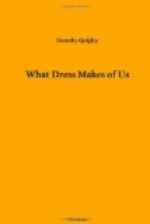CHAPTER I.
HOW WOMEN OF CERTAIN TYPES SHOULD DRESS THEIR HAIR.
The pleasing, but somewhat audacious statement of the clever writer who asserted, “In the merciful scheme of nature, there are no plain women,” is not as disputable as it may seem. Honest husbands, to be sure, greet the information with dissenting guffaws; gay deceivers reflect upon its truth by gallantly assenting to it, with a mocking little twinkle in their eyes; and pretty women, upon hearing it, remark sententiously “Blind men and fools may think so.” Discerning students of womankind, however, know that if every woman would make the best of her possibilities, physically, mentally, and spiritually, it would be delightfully probable that “in the merciful scheme of nature” there need be no plain women.
Have we not Lord Chesterfield’s word for it, that “No woman is ugly when she is dressed”?
It is no unworthy study to learn to make the best of, and to do justice to, one’s self. Apropos of this, to begin—where all fascinating subjects should begin—at the head, it behooves every woman who wishes to appear at her best, to study the modelling of her face that she may understand both its defective and perfect lines. By a proper arrangement of her hair a woman can do much to obscure or soften her bad features, and heighten the charm of her good ones.
Romancers have written, and poets have sung, of the bewitchment in nut-brown locks, golden tresses, and jetty curls. Every woman, if so inclined, may prove for herself the transfiguring effect in a becoming coiffure. In fact, the beauty of a woman’s face and her apparent age are greatly affected by the way she wears her hair.
A most important detail that too few consider, is, the proper direction in which to comb the hair. Women literally toss their tresses together without any attention to the natural inclination of the individual strands or fibres. They comb their hair “against the grain.” Those who do so never have beautifully and smoothly arranged coiffures. Each little hirsute filament has a rebellious tendency to go in the direction nature intended it should, and refuses to “stay where it is put,” giving the head in consequence, an unkempt and what is termed an “unladylike” appearance. The criss-cross effect resulting from combing and arranging the hair contrary to “the grain” is conspicuously apparent in the coiffure of no less a personage than Eleanora Duse, who, as may be seen from the picture, pays little attention to the natural tendency of the dark tresses that cover her shapely head. The bang has the dishevelled appearance of a pile of jack-straws. The side-locks instead of being combed or brushed to follow the contour of the head, fall loosely and fly in opposite directions.
[Illustration: No. 2]
The difference in appearance between the women of the smart sets in America and those of less fashionable circles is due, in a great measure, to the beautifully dressed coiffures of the former. A hair-dresser arranges, at least once a week, the hair of the modish woman if her maid does not understand the art of hair-dressing. Many women of the wealthy world have their maids taught by a French coiffeur.




